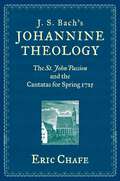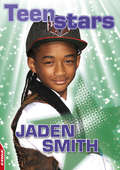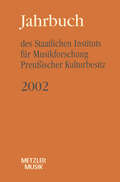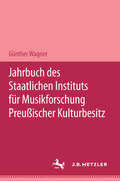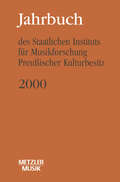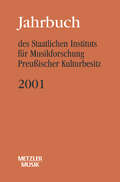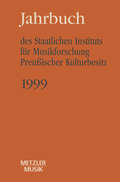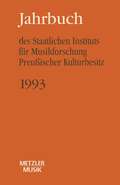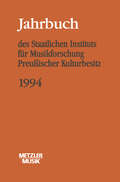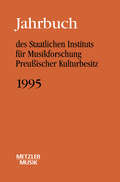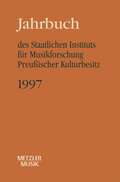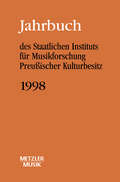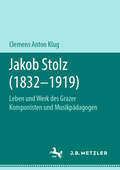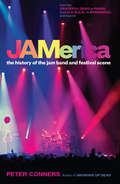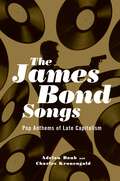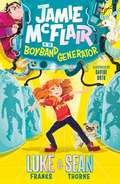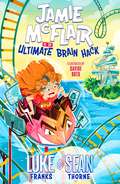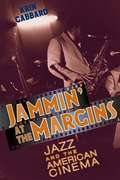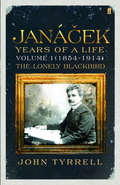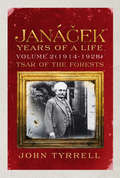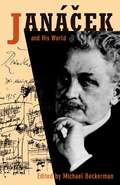- Table View
- List View
J. S. Bach's Johannine Theology: The St. John Passion and the Cantatas for Spring 1725
by Eric ChafeBach's Johannine Theology: The St. John Passion and the Cantatas for Spring 1725 is a fertile examination of this group of fourteen surviving liturgical works. Renowned Bach scholar Eric Chafe begins his investigation into Bach's theology with the composer's St. John Passion, concentrating on its first and last versions. Beyond providing a uniquely detailed assessment of the passion, Bach's Johannine Theology is the first work to take the work beyond the scope of an isolated study, considering its meaning from a variety of musical and historical standpoints. Chafe thereby uncovers a range of theological implications underlying Bach's creative approach itself. Building considerably on his previous work, Chafe here expands his methodological approach to Bach's vocal music by arguing for a multi-layered approach to religion in Bach's compositional process. Chafe bases this approach primarily on two aspects of Bach's theology: first, the specific features of Johannine theology, which contrast with the more narrative approach found in the Synoptic Gospels (Matthew, Mark, Luke); and second, contemporary homiletic and devotional writings - material that is not otherwise easily accessible, and less so in English translation. Bach's Johannine Theology provides an unprecedented, enlightening exploration of the theological and liturgical contexts within which this music was first heard.
Jaden Smith (EDGE: Teen Stars #3)
by Clare HibbertWelcome to Teen Stars! Whether you're already a fan, or just want to find out more, this series has something for everyone who's into the teen celebrity scene.
Jahrbuch des Staatlichen Instituts für Musikforschung Preußischer Kulturbesitz 2002
Das in Kiew wiederaufgefundene und im Dezember 2001 nach Berlin zurückgekehrte Notenarchiv der Sing-Akademie ist - mit Beiträgen von Ch. Wolff, H. Hell, G. Wagner, P. Wollny, Ch. Henzel und U. Leisinger - einer der Schwerpunkte des neuen Jahrbuchs. Weitere Beiträge - über R. Strauss' Neuausgabe von Berlioz' Instrumentationslehre sowie den Wiener Kontrabaß - dokumentieren die Arbeit im Musikinstrumenten-Museum bzw. befassen sich am Beispiel von Vincenzo Righini, Hans Pfitzner und Ernst Pepping mit Stationen der Musikgeschichte Berlins. Ein letzter Schwerpunkt gilt der Geschichte musikwissenschaftlicher Institutionen in Wien, München und an den preußischen Universitäten in den 1880er Jahren.
Jahrbuch des Staatlichen Instituts für Musikforschung Preußischer Kulturbesitz 2003
Im Mittelpunkt des Jahrbuchs 2003 stehen mehrere Beiträge über das wiederaufgefundene Notenarchiv der Sing-Akademie zu Berlin. Weitere Aufsätze widmen sich u.a. dem Begriff "Berliner Klassik", Kompositionen von Fanny Hensel und W. A. Mozart sowie dem "Violinkonzert" von Alban Berg.
Jahrbuch des Staatlichen Instituts für Musikforschung (SIM) Preußischer Kulturbesitz: 2000
Die historische Aufführungspraxis ist das zentrale Thema des Jahrbuchs 2000. Das Spektrum reicht dabei vom Frühbarock bis zum 19. Jahrhundert. Claudia Theis und Nicole Restle beschäftigen sich mit den großbesetzten Werken Johann Hermann Scheins, Peter Wollny mit Bachs Nachfolger Gottlob Harrer, Christoph Wolff mit der Frage, wie »die ehemalige Arth von Music« im Falle Bachs geklungen hat. Mit dem Wandel der Rezeptionsvoraussetzungen der Barockmusik im 19. Jahrhundert beschäftigen sich Robert Hill, Konstantin Restle und Günther Wagner. Beiträge von Nors S. Josephson (über Form- und Strukturprobleme im Schaffen Bachs) sowie von Christoph Henzel (über die Berliner Hofmusik zur Zeit Friedrichs II.) runden diesen Teil ab. Ergänzt wird dieser Schwerpunkt durch Aufsätze von Reinhold Brinkmann über die Wirkung Max Regers sowie von Julia Wechsler über Opernpläne Alban Bergs.
Jahrbuch des Staatlichen Instituts für Musikforschung (SIM) Preußischer Kulturbesitz: 2001
Die Musikgeschichte Berlins in der zweiten Hälfte des 18. Jahrhunderts ist einer der Schwerpunkt des neuen Jahrbuchs. Walter Salmen beschäftigt sich mit dem Wirken des Hofkapellmeisters Johann Friedrich Reichardt; Norbert Miller reflektiert die Sonderstellung Berlins im Hinblick auf Klassizismus und frühe Romantik. Ulrich Leisinger beschäftigt sich mit Wilhelm Friedrich Ernst Bach, dem letzten musikalisch bedeutenden Nachfahren des Thomaskantors, Günther Wagner mit Carl Philipp Emanuel Bachs Wirken in Potsdam und Berlin zwischen 1740 und 1768. Mehrere Beiträge, u.a. von Christian Ahrens, Konstantin Restle, Wolf Dieter Neupert, Sabine Hoffmann, Gerhart Darmstadt und Thomas Schiegnitz sind Fragen des historischen Musikinstrumentenbaus gewidmet. Abgeschlossen wird der Band durch Aufsätze zur Figurenlehre (Janina Klassen, Heinz von Loesch) und zur Stadt als Raum und Ideengeber für den Komponisten (Martin Elste).
Jahrbuch des Staatlichen Instituts für Musikforschung (SIM) Preußischer Kulturbesitz: 1997
Das Jahrbuch 1999 hat drei inhaltliche Schwerpunkte: die Musik der Bach-Zeit, Formkategorien in Instrumentalwerken des Fin de Siècle und der Neuen Musik sowie die instrumentenkundliche Forschung des Instituts.
Jahrbuch des Staatlichen Instituts für Musikforschung (SIM) Preußischer Kulturbesitz, Jahrbuch 1998
Das Jahrbuch 1998 orientiert sich an zwei inhaltlichen Schwerpunkten: Johann Sebastian Bach und die Zeit seiner Söhne einerseits und die Musik der ersten Hälfte des 20.Jahrhunderts, insbesondere der Wíener Schule, andererseits. Formkategorien in Instrumentalwerken des Fin de Siècle und der Neuen Musik behandeln die Vorträge von Werner Breig, Regina Busch, Renate Groth, Janina Klassen, Friedhelm Krummacher, Claudia Maurer Zenck, Dörte Schmidt, Martina Sichardt und Walter Werbeck, die aus Anlaß eines Symposiums zu Ehren Werner Breigs im September 1997 in Bochum gehalten wurden. Dem Umkreis der Bach-Zeit gelten die Beiträge von Werner Braun, Clemens Goldberg und Pierangelo Schiera. Mit den Anfängen des Hammerklaviers in Italien und Deutschland beschäftigen sich Christian Ahrens, Dieter Krickeberg und Konstantin Restle. Quellenkundliche Beiträge zu Graun (Christoph Henzel), Berliner Kopisten im Umfeld von Quantz (Peter Wollny) und Salieri (Ernst Dreyer) runden den Band ab.
Jakob Stolz (1832-1919): Leben und Werk des Grazer Komponisten und Musikpädagogen
by Clemens Anton KlugDer Grazer Musiker, Komponist und Musikpädagoge Jakob Stolz (1832-1919) wäre heute gänzlich vergessen, wenn nicht seinem jüngsten Sohn Robert Stolz als Komponist und Dirigent eine der bedeutendsten Karrieren des 20. Jahrhunderts beschieden gewesen wäre. Dieses Buch stellt das Leben, die familiäre Herkunft, die Ausbildung und mannigfaltige musikalische Tätigkeit von Jakob Stolz dar. Außerhalb seiner Musikschule trat er über viele Jahrzehnte mit eigenen Kompositionen, Konzertauftritten und musikalischen Vorträgen in Erscheinung und wurde damit bereits zu Lebzeiten zu einer lokalen Legende. Mit seinem Tod vor genau 100 Jahren erlosch sein Nimbus und er wurde sehr schnell vergessen. Neben zahlreichen zeitgenössischen Abbildungen, Artikeln und Originaldokumenten wie auch einem systematischen Werkeverzeichnis richtet diese Monographie den Blick auf eine bedeutende Persönlichkeit des österreichischen Musiklebens im 19. Jahrhundert.
JAMerica: The History of the Jam Band and Festival Scene
by Peter ConnersThe term "jam band” is used to categorize a type of music that favors improvisation and musicianship over concise riffs, hooks, and traditional songwriting structure. The term also helps define the fiercely dedicated fans of the music as accurately as it does the bands. Much as with the Grateful Dead-the progenitors of the jam band scene-the survival of the scene depends upon a symbiotic relationship with fans. Jam bands nurture a close relationship with their fans, fostered through constant touring and the mutual belief that each performance is a unique, shared event.JAMerica tells the story of the roots, evolution, values, and passion of the jam band scene in the words of those who know it best. Modeling itself on such books as Edie: American Girl by George Plimpton and Jean Stein (an oral history of the life of Edie Sedgewick ) and Please Kill Me: The Uncensored Oral History of Punk by Legs McNeil and Gillian McCain, the book is an oral history of the jam band scene, integrating stories from such bands as the Grateful Dead, Phish, Widespread Panic, Dave Matthews Band, moe., Leftover Salmon, String Cheese Incident, Umphrey's McGee, and dozens more. Interviews focus on the history of individual bands and how they communally shaped the larger jam band community, along with songwriting, relationships with fans, business models, and the importance (including the joys and war stories) of touring, including early gigs and venues (e.g. the Wetlands in New York City and the landmark H.O.R.D.E. Festival) that supported the emergence of the jam band scene.
The James Bond Songs: Pop Anthems of Late Capitalism
by Adrian Daub Charles KronengoldStarting with 1964's Goldfinger, every James Bond film has followed the same ritual, and so has its audience: after an exciting action sequence the screen goes black and the viewer spends three long minutes absorbing abstract opening credits and a song that sounds like it wants to return to 1964. In The James Bond Songs authors Adrian Daub and Charles Kronengold use the genre to trace not only a changing cultural landscape, but also evolving conceptions of what a pop song is. They argue that the story of the Bond song is the story of the pop song more generally, and perhaps even the story of its end. Each chapter discusses a particular segment of the Bond canon and contextualizes it in its era's music and culture. But the book also asks how Bond and his music reflected and influenced our feelings about such topics as masculinity, race, money, and aging. Through these individual pieces the book presents the Bond song as the perfect anthem of late capitalism. The Bond songs want to talk about the fulfillment that comes from fast cars, shaken Martinis and mindless sex, but their unstable speakers, subjects, and addressees actually undercut the logic of the lifestyle James Bond is sworn to defend. The book is an invitation to think critically about pop music, about genre, and about the political aspects of popular culture in the twentieth century and beyond.
The James Bond Songs: Pop Anthems of Late Capitalism
by Adrian Daub Charles KronengoldStarting with 1964's Goldfinger, every James Bond film has followed the same ritual, and so has its audience: after an exciting action sequence the screen goes black and the viewer spends three long minutes absorbing abstract opening credits and a song that sounds like it wants to return to 1964. In The James Bond Songs authors Adrian Daub and Charles Kronengold use the genre to trace not only a changing cultural landscape, but also evolving conceptions of what a pop song is. They argue that the story of the Bond song is the story of the pop song more generally, and perhaps even the story of its end. Each chapter discusses a particular segment of the Bond canon and contextualizes it in its era's music and culture. But the book also asks how Bond and his music reflected and influenced our feelings about such topics as masculinity, race, money, and aging. Through these individual pieces the book presents the Bond song as the perfect anthem of late capitalism. The Bond songs want to talk about the fulfillment that comes from fast cars, shaken Martinis and mindless sex, but their unstable speakers, subjects, and addressees actually undercut the logic of the lifestyle James Bond is sworn to defend. The book is an invitation to think critically about pop music, about genre, and about the political aspects of popular culture in the twentieth century and beyond.
Jamie McFlair Vs The Boyband Generator: Book 1 (Jamie McFlair)
by Luke Franks Sean Thorne"Funny, zany, the right amount of cheeky and answers that BIG question - what is really going on with 'Boy Band hair?'" - Jenny Pearson, bestselling author of The Super Miraculous Journey of Freddie YatesFour best friends, two boybands, and an evil uncle with a monstrous secret - what could possibly go wrong? KID NORMAL meets BRITAIN'S GOT TALENT in this hilarious new series for 8+ readers.This story begins with a snoring pug, a forgetful grandma, and the hero of this adventure in a really bad mood. There is also a goose on the loose. We just wanted to warn you.Jamie McFlair's favourite band got a slot performing on the country's biggest talent show, but it went wrong thanks to Barry Bigtime (in an 'incident' involving a chocolate milkshake and worn underpants - don't ask).Barry is a music big shot, all round nasty man...and Jamie's Uncle. The next day, he launches his own massive new band and Jamie smells a rat. With the help of three trusty best friends - popular Daisy, no-nonsense Jenners, and timid Mel - Jamie vows to uncover Barry's dastardly plan.But Jamie doesn't know about BARRY'S SECRET. A secret that is TERRIBLE and SHOCKING and VERY STRANGE. There's something hidden in Barry's basement - a machine that is the key to his musical success. But what happens when the boyband generator goes wrong? We'll give you a clue: it is NOT GOOD and THE ENTIRE WORLD is at risk. Can Jamie stop Barry Bigtime before it's too late?
Jamie McFlair Vs The Ultimate Brain Hack (Jamie McFlair)
by Luke Franks Sean ThorneThe laugh-out-loud new adventure featuring Jamie McFlair, from comedy duo Luke and Sean. Packed full of illustrations, this is perfect for 8+ readers and fans of Kid Normal and The Great Dream Robbery.Welcome to a new adventure starring our courageous young heroine Jamie McFlair, who so successfully thwarted her nasty uncle's monstrous plans a few months ago. But as we rejoin her, Jamie McFlair is ... sad. HUH!? Well, she just found out that she and her best friends - Daisy, Mel, and Jenners - are being split up and sent to different schools. Not one to admit defeat, Jamie discovers a way out of this unpleasant situation: Rubbsling's Academy for Creators, a school for famous kids. Because of their antics stopping the evil mastermind Barry Bigtime, Jamie and her friends have attracted some fans. It's enough to get them accepted into the school - they can stay together!But the school is ... weird. Located on a remote island, with strange teachers who give out punishments for NOT having your phone out in class, it all seems geared towards building the students' social media profiles. Though Daisy enjoys the attention, Jamie is suspicious that something isn't right. What is really going on at this school?Poor Jamie. What she's about to discover is that Barry Bigtime is bigtime back. Fallen from grace, outcast by society, and determined for revenge on Jamie, the school is the secret hiding place for his new plan...A plan to control the brains of all the children at the school, to make them do what he wants. A plan that is the first step towards controlling EVERY BRAIN ON THE PLANET!What questionable science is this!? How will this madness end?! Can Jamie rescue her friends and defeat Barry Bigtime once more, or will she become victim to THE ULTIMATE BRAIN HACK?
Jammin' at the Margins: Jazz and the American Cinema (Phoenix Fiction Ser.)
by Krin GabbardAmerican cinema has long been fascinated by jazz and jazz musicians. Yet most jazz films aren't really about jazz. Rather, as Krin Gabbard shows, they create images of racial and sexual identity, many of which have become inseparable from popular notions of the music itself. In Jammin' at the Margins, Gabbard scrutinizes these films, exploring the fundamental obsessions that American culture has brought to jazz in the cinema. Gabbard's close look at jazz film biographies, from The Jazz Singer to Bird, reveals Hollywood's reluctance to acknowledge black subjectivity. Black and even white jazz artists have become vehicles for familiar Hollywood conceptions of race, gender, and sexuality. Even Scorsese's New York, New York and Spike Lee's Mo' Better Blues have failed to disentangle themselves from entrenched stereotypes and conventions. Gabbard also examines Hollywood's confrontation with jazz as an elite art form, and the role of the jazz trumpet as a crucial signifier of masculinity. Finally, he considers the acting careers of Louis Armstrong, Nat King Cole, and Hoagy Carmichael; Duke Ellington's extraordinary work in films from 1929 until the late 1960s; and the forgotten career of Kay Kyser, star of nine Hollywood films and leader of a popular swing band. This insightful look at the marriage of jazz and film is a major contribution to film, jazz, and cultural studies.
Janacek (1854-1914): The Lonely Blackbird
by Dr John TyrrellJohn Tyrrell's biography of the Leos Janácek is the culmination of a life's work in the field. It stands upon his existing documentary studies of Janácek's operas and translations of other key sources and his examination of thousands of still unpublished letters and other documents in the Janácek archive in Brno. Altogether it provides the most detailed account of Janácek's life in any language and offers new views of Janácek as composer, writer, thinker and human being. Volume 1, which goes up to the outbreak of the First World War and Janácek's sixtieth birthday in the summer of 1914, consists of chronological chapters providing a straightforward account of Janácek's life year by year and another forty contextual chapters. Topics include on-going sequences ('Music as autobiography I', etc.; 'Janácek's knowledge of opera I', etc.) and individual chapters on Janácek as a teacher, as a theorist, as an music ethnographer, on his speech-melody theory, his relationship to particularly influential operas (Tchaikovsky's Queen of Spades, Charpentier's Louise), on his mentors (such as Antonín Dvorák) and his bêtes noires (such as Karel Kovarovic). A particular feature are the specially commissioned chapters on Janácek's health by Dr Stephen Lock (one of the editors of the Oxford Illustrated Companion to Medicine, OUP 1994 and 2001, editor of the British Medical Journal, 1975-91, and a Janácek enthusiast since the early postwar broadasts on the Third Programme), and on Janácek's earnings and finances by Dr Jirí Zahrádka (curator of the Janácek archive in Brno, and editor of authentic editions of Sárka and The Excursions of Mr Broucek).
Janacek (1914-1928): Tsar of the Forests
by Dr John TyrrellVolume 2 opens at the the outbreak of the First World War and at the time of Janácek's lowest ebb. Within two years, however, his fortunes were transformed by the Prague production of Jenufa This led to international fame and fortune and to the magnificent creative flowering in which the elderly composer wrote most of his best-known works. His personal life was affected by his public affair with Gabriela Horvátová and his friendship with Kamila Stösslová, whom he saw as the inspiration for many of his late works.
Janácek and His World
by Michael BeckermanOnce thought to be a provincial composer of only passing interest to eccentrics, Leos Janácek (1854-1928) is now widely acknowledged as one of the most powerful and original creative figures of his time. Banned for all purposes from the Prague stage until the age of 62, and unable to make it even out of the provincial capital of Brno, his operas are now performed in dynamic productions throughout the globe. This volume brings together some of the world's foremost Janácek scholars to look closely at a broad range of issues surrounding his life and work. Representing the latest in Janácek scholarship, the essays are accompanied by newly translated writings by the composer himself. The collection opens with an essay by Leon Botstein who clarifies and amplifies how Max Brod contributed to Janácek 's international success by serving as "point man" between Czechs and Germans, Jews and non-Jews. John Tyrrell, the dean of Janácek scholars, distills more than thirty years of research in "How Janácek Composed Operas," while Diane Paige considers Janácek's liason with a married woman and the question of the artist's muse. Geoffrey Chew places the idea of the adulterous muse in the larger context of Czech fin de siècle decadence in his thoroughgoing consideration of Janácek's problematic opera Osud. Derek Katz examines the problems encountered by Janácek's satirically patriotic "Excursions of Mr. Broucek" in the post-World War I era of Czechoslovak nationalism, while Paul Wingfield mounts a defense of Janácek against allegations of cruelty in his wife's memoirs. In the final essay, Michael Beckerman asks how much true history can be culled from one of Janácek's business cards. The book then turns to writings by Janácek previously unpublished in English. These not only include fascinating essays on Naturalism, opera direction, and Tristan and Isolde, but four impressionistic chronicles of the "speech melodies" of daily life. They provide insight into Janácek's revolutionary method of composition, and give us the closest thing we will ever have to the "heard" record of a Czech pre-war past-or any past, for that matter.
Janácek's Operas: A Documentary Account
by John TyrrellOne of the most original and engaging composers of the twentieth century, Leos Janáçek is now regarded as one of its major musical dramatists. His operas have become a regular part of the repertory, but a full understanding of their diverse subjects and backgrounds has been hampered by the lack of source materials in English. John Tyrrell has here selected and translated the chief literary documents relating to the genesis and early performances of each of the composer's nine operas and presented them in the form of a compelling documentary narrative. Janáçek was a vigorous letter-writer and kept every letter he received. A vast quantity of material on his life has survived, providing a unique insight into his working methods and attitudes toward his operas. Scrupulously translated and annotated, the sources in this volume have not previously been brought together in this way. Some have appeared in scattered and often inaccessible publications in Czech, and others, such as the sequence of daily letters that Janáçek wrote to his wife during the rehearsals for the Prague premiere of Jenufa, or his instructions to his librettist for Fate, have never been published before. The book is complemented by a chronology of Janáçek's operas keyed to the numbered documents in each chapter, a bibliography, and a list of sources. Drawing on twenty-five years of work at the Janáçek archive in Brno, this work is a classic of music documentary scholarship.Originally published in 1992.The Princeton Legacy Library uses the latest print-on-demand technology to again make available previously out-of-print books from the distinguished backlist of Princeton University Press. These editions preserve the original texts of these important books while presenting them in durable paperback and hardcover editions. The goal of the Princeton Legacy Library is to vastly increase access to the rich scholarly heritage found in the thousands of books published by Princeton University Press since its founding in 1905.
Janelle Monáe’s The ArchAndroid (33 1/3)
by Alyssa FavreauIn Janelle Monáe's full-length debut, the science fiction concept album The ArchAndroid, the android Cindi Mayweather is on the run from the authorities for the crime of loving a human. Living in 28th century Metropolis, Cindi fights for survival, soon realizing that she is in fact the prophesied ArchAndroid, a robot messiah meant to liberate the masses and lead them toward a wonderland where all can be free.Taking into account the literary merit of Monáe's astounding multimedia body of work, the political relevance of the science fictional themes and aesthetics she explores, and her role as an Atlanta-based pop cultural juggernaut, this book explores the lavish world building of Cindi's story, and the many literary, cinematic, and musical influences brought together to create it. Throughout, a history of Monáe's move to Atlanta, her signing with Bad Boy Records, and the trials of developing a full-length concept album in an industry devoted to the production of marketable singles can be found, charting the artist's own rise to power. The stories of Monáe and of Cindi are inextricably entwined, each making the other more compelling, fantastical, and deeply felt.
Janelle Monáe’s The ArchAndroid (33 1/3)
by Alyssa FavreauIn Janelle Monáe's full-length debut, the science fiction concept album The ArchAndroid, the android Cindi Mayweather is on the run from the authorities for the crime of loving a human. Living in 28th century Metropolis, Cindi fights for survival, soon realizing that she is in fact the prophesied ArchAndroid, a robot messiah meant to liberate the masses and lead them toward a wonderland where all can be free.Taking into account the literary merit of Monáe's astounding multimedia body of work, the political relevance of the science fictional themes and aesthetics she explores, and her role as an Atlanta-based pop cultural juggernaut, this book explores the lavish world building of Cindi's story, and the many literary, cinematic, and musical influences brought together to create it. Throughout, a history of Monáe's move to Atlanta, her signing with Bad Boy Records, and the trials of developing a full-length concept album in an industry devoted to the production of marketable singles can be found, charting the artist's own rise to power. The stories of Monáe and of Cindi are inextricably entwined, each making the other more compelling, fantastical, and deeply felt.
